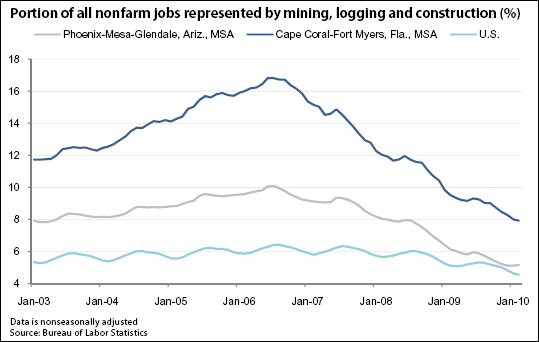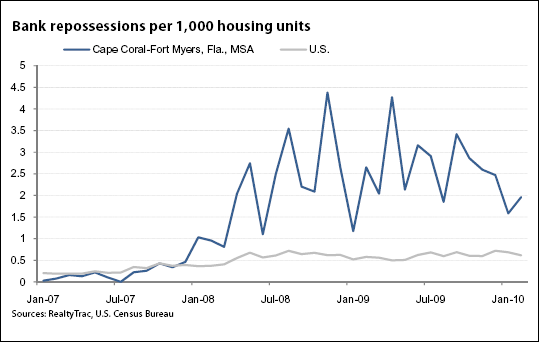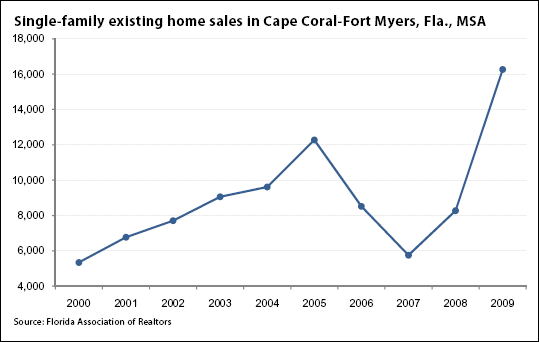In Florida, one city bet its future on growth. On its Web site, the city of Cape Coral boasts that the town has more miles of canals than Venice, Italy, dubbing it a "waterfront wonderland." For its motto, it adopted "City of Superlatives."
The city's motto rings true but in a rather ignominious manner. Instead of climbing the ranks of popular tourist destinations, the Cape Coral-Fort Myers, Fla., MSA, has found itself near the top of lists enumerating America's most battered housing markets.
"The carnage that has been done to the values in our market, I don't know, maybe Las Vegas, but I don't know of another city that has seen the very, very tragic effects of the value [declines]. We've lost a whole generation of wealth. All the equity's gone — for everyone," said Steve Koffman, a real estate broker associate with Century 21 Sunbelt, a real estate firm in the metro area.
And local real estate agents point to Cape Coral as a primary contributor in securing the metro area's infamy. In contrast, just across the water in Fort Myers, prices were a bit more stable during the boom days. In fact, Marc Joseph, a real estate broker in Cape Coral, told SNL that Fort Myers' struggles amount to collateral damage from Cape Coral's bust.
A curtain of growth
A fundamental contributor to the exponential price appreciation seen throughout much of South Florida was the idea that land was finite, and fevered demand for property near the coast created an investment philosophy among homebuyers, Andrea Heuson, a professor of finance at the University of Miami, told SNL.
"There is only so much buildable land in South Florida, and when you get, especially on the coast, a constraint on supply or an apparent constraint on supply, then prices can rise significantly faster than if you think about  Atlanta," Heuson said. "It's kind of a classic example of when prices start to rise in Atlanta, they just sell another farm."
Atlanta," Heuson said. "It's kind of a classic example of when prices start to rise in Atlanta, they just sell another farm."
But, unlike much of coastal South Florida, land was abundant in Cape Coral. The city bet on residential housing from the get-go, with much of the city's land dedicated to single-family, pre-platted land plots. A city-commissioned study in 2008 showed that just 8% of Cape Coral's total land area was zoned for commercial use in 2005. In all, the study showed the city had 270,000 platted lots despite being a city of just 57,952 households, according to the U.S. Census Bureau.
In essence, Cape Coral received the price-pushing investment mentality that permeated Florida while also having cheap land in spades. Rather than acting as a check on prices like plentiful land has done in places such as Atlanta and  Indianapolis, Cape Coral's overflow of lots created a self-reinforcing cycle by allowing developers to toss up houses quickly and cheaply while a growing investment community bid prices ever higher.
Indianapolis, Cape Coral's overflow of lots created a self-reinforcing cycle by allowing developers to toss up houses quickly and cheaply while a growing investment community bid prices ever higher.
"The crazy money that was coming through this area enabled all the smaller, mom-and-pop investors to go to those builders that would normally only produce maybe five homes a year — well, they would produce 100," Joseph said. "And the guy cutting your hair was buying five homes at $1,000 down and he's making $35,000 a year." Before the boom, lot prices in the city stood at roughly $3,000. By the time the housing bubble reached its peak in 2006, lots were selling for nearly $90,000, Joseph said. Now, land prices have tumbled back down to $3,000. Home prices performed similarly, shooting up 136.2% from the 2001 first quarter through the 2006 first quarter and then crashing, according to the Federal Housing Finance Agency.
Price appreciation was so rapid and attractive that buyers would put $1,000 down to get a home built and resell it for $30,000 or more in profit without ever actually acquiring title to the property, Brian Fulton, office manager of Tomasso Mortgage in the metro area, told SNL.
"I think our area was hit hard because people were betting on the growth. We were considered one of the fastest-growing areas in the nation, so I think we were hit harder than most of Florida," Gary Jackson, director of the Regional Economic Research Institute at Florida Gulf Coast University in Fort Myers, told SNL.
There was nothing behind the curtain of growth. With so little commercial space in Cape Coral, the metro area became especially reliant on construction for employment. By June 2006, 16.8% of all jobs in the metro area came from the mining, logging and construction sector (the Bureau of Labor Statistics does not break out construction jobs for the Cape Coral-Fort Myers, MSA). By contrast, the national average reliance on the sector that month was 6.3%. Even the notoriously growth-dependant  Phoenix-Mesa-Glendale, Ariz., MSA (the U.S. Office of Management and Budget changed the name of the MSA from Phoenix-Mesa-Scottsdale, Ariz., in December 2009), was far less reliant on development, with 10.1% of its jobs coming from mining, logging and construction in June 2006.
Phoenix-Mesa-Glendale, Ariz., MSA (the U.S. Office of Management and Budget changed the name of the MSA from Phoenix-Mesa-Scottsdale, Ariz., in December 2009), was far less reliant on development, with 10.1% of its jobs coming from mining, logging and construction in June 2006.
"I can remember driving up the west [Florida] coast and saying, 'Where are all these people going to work?'" Heuson said.

Unsurprisingly, with construction jobs falling off a cliff, Cape Coral-Fort Myers has posted a towering unemployment rate, hitting 13.9% in February, according to a preliminary report; the national average was 10.4% in February, non-seasonally adjusted. Whatever housing market metric one picks, Cape Coral-Fort Myers is near the top — in a bad way. The metro area has seen prices fall 49.5% from the 2006 first quarter through the 2009 fourth quarter, larger than the 42.0% drop posted by California's infamous  Inland Empire and the 49.3% decline seen in Nevada's eviscerated
Inland Empire and the 49.3% decline seen in Nevada's eviscerated  Las Vegas-Paradise MSA, according to the FHFA's all-transactions index. With unemployment shooting up and prices tumbling, it comes as little surprise that Cape Coral-Fort Myers is also one of the nation's most foreclosure-prone neighborhoods. The metro posted the
Las Vegas-Paradise MSA, according to the FHFA's all-transactions index. With unemployment shooting up and prices tumbling, it comes as little surprise that Cape Coral-Fort Myers is also one of the nation's most foreclosure-prone neighborhoods. The metro posted the  second-highest foreclosure rate of any metro area in the nation during 2009, according to RealtyTrac.
second-highest foreclosure rate of any metro area in the nation during 2009, according to RealtyTrac.
The upward trend in bank repossessions per 1,000 housing units in the MSA dwarfs the U.S. average so much that the nation's 69.0% jump in foreclosure rate from January 2008 through February 2010 is nearly imperceptible on the below graph.

"[Cape Coral] is ground zero for foreclosures. I mean, Lee County, it's a bad time to be No. 1. We're No. 1 in the worst unemployment rate and No. 1 in foreclosures; that's a pretty deadly combination," said Kevin Jursinski, a Fort Myers-based attorney who handles foreclosures. Playing a role in the sharp peaks and valleys in the MSA's bank repossession rate is the Florida way of dealing with foreclosures. Being a judicial foreclosure state, the foreclosure process has to go through the courts. Cape Coral created such a backlog in the judicial system that the courts adopted a "Rocket Docket" system in which foreclosures were disposed of within seconds. Lawyers representing banks have been known to rip through 120 foreclosures in one day, Jursinski said.
A bit of hope
Despite all the carnage, real estate agents are singing a tune of hope and optimism. The nearly 50% drop in prices has put the price of homes minutes from the water under $100,000. That has attracted a flood of interest from foreigners and out-of-towners looking for a second home.
Marc Joseph, the real estate broker, defined the recent activity as "ungodly amounts of cash coming here." And sales have bounced back in a big way. Indeed, Brian Fulton at Tomasso Mortgage said roughly 65% of sales in 2009 were all-cash deals, a ratio that is expected to grow in 2010.
The spike in sales goes beyond out-of-towners searching for a sunny second home. Fulton said flipping has become more common, noting one recent sale in which an investor purchased a property for $64,000, put roughly $12,000 to $14,000 into repairs and resold the home for $109,000.
For the 2009 full year, the metro area recorded 16,260 single-family sales, more than the bubble-era peak of 12,273 single-family sales, according to the Florida Association of Realtors.

Yet no one is expecting a painless recovery. As Kevin Jursinski, the lawyer, put it, the metro area is still buckling under "a mountain of supply and then there is a little river underneath it which is the demand." There are more than 11,000 single-family homes for sale. The multifamily picture is even worse, with 6,500 units for sale, which is more than the full year's worth of sales in 2009, according to data compiled by Denny Grimes & Co. Inc. And with foreclosures failing to keep pace with delinquencies, the much-talked-about  shadow inventory casts a dark cloud over the Cape Coral-Fort Myers housing market.
shadow inventory casts a dark cloud over the Cape Coral-Fort Myers housing market.
Therefore, Steve Koffman, the real estate agent, has modest expectations for any recovery.
"I think we're still years away [from appreciation]. I think we'll see more traditional increases in value as we get closer to the end of the pipeline being flushed out," Koffman said. "We'll see traditional appreciation. I mean, everybody would love to see 5% to 10% a year and just be happy with it."
Gary Jackson at Florida Gulf Coast University agreed. "I think there are some positive signs. I can tell you, though, that we have a long way to go," he said.
For a city that bet on growth and laid claim to superlatives, a bit of modesty might be welcome.


